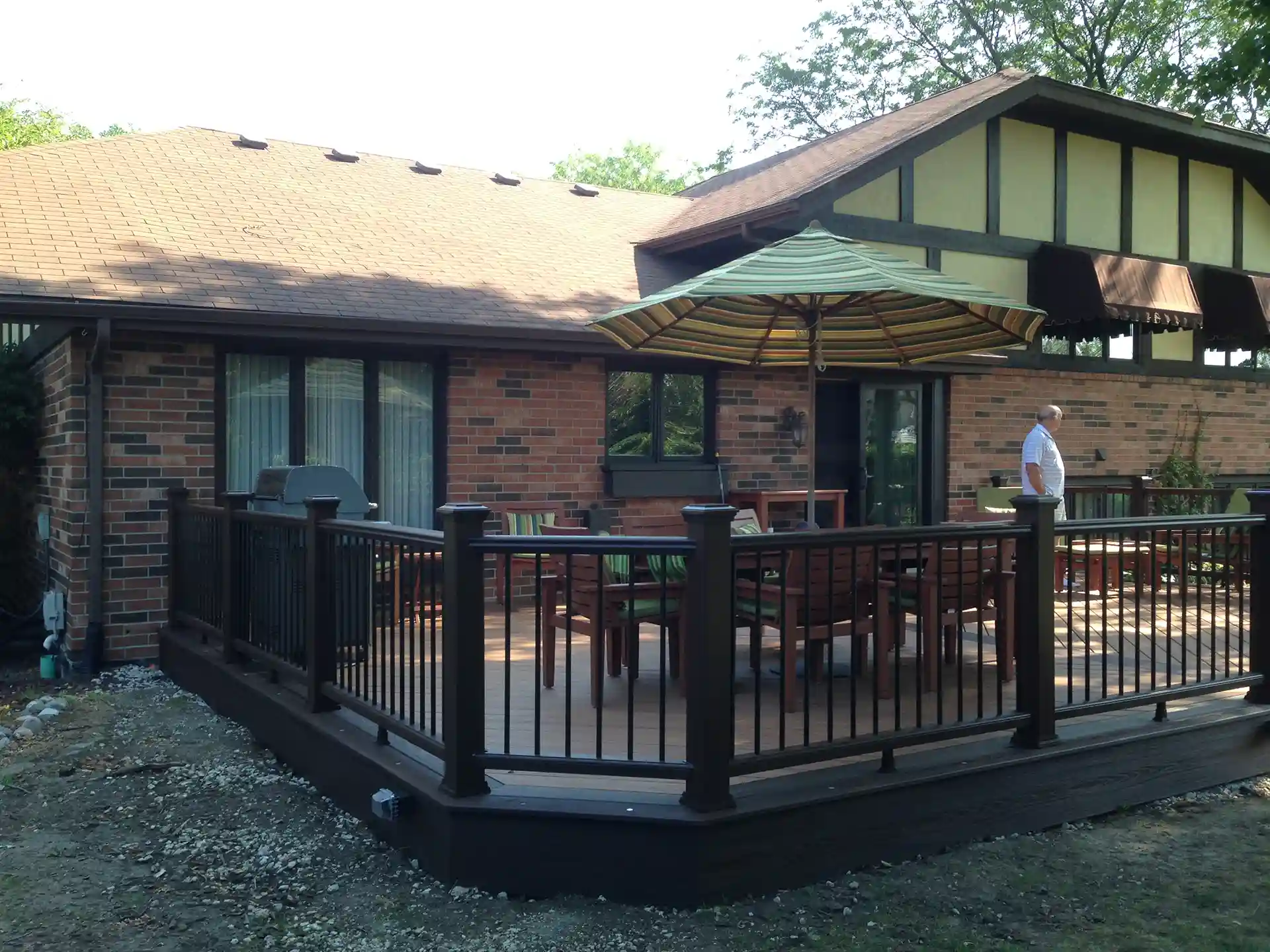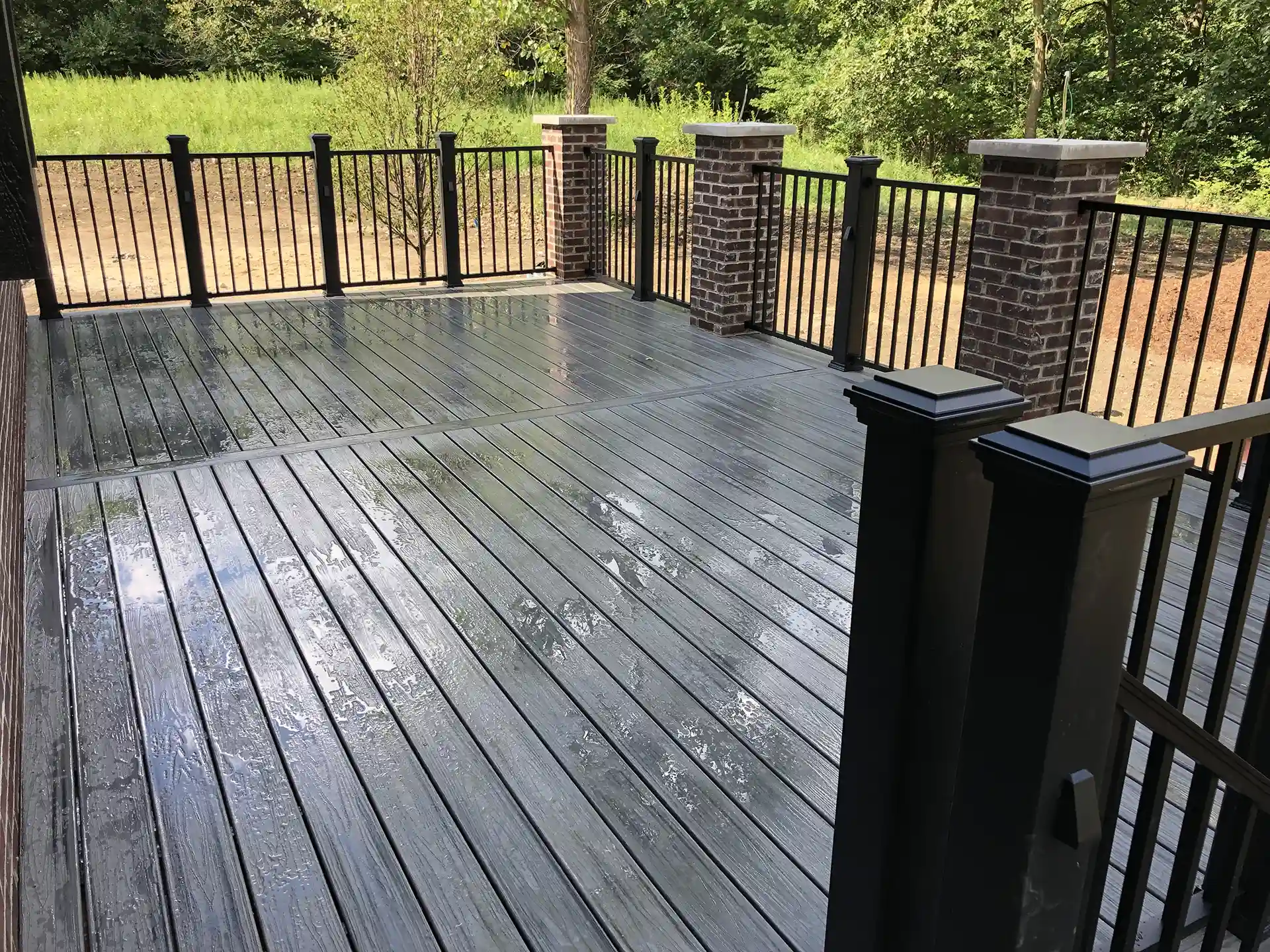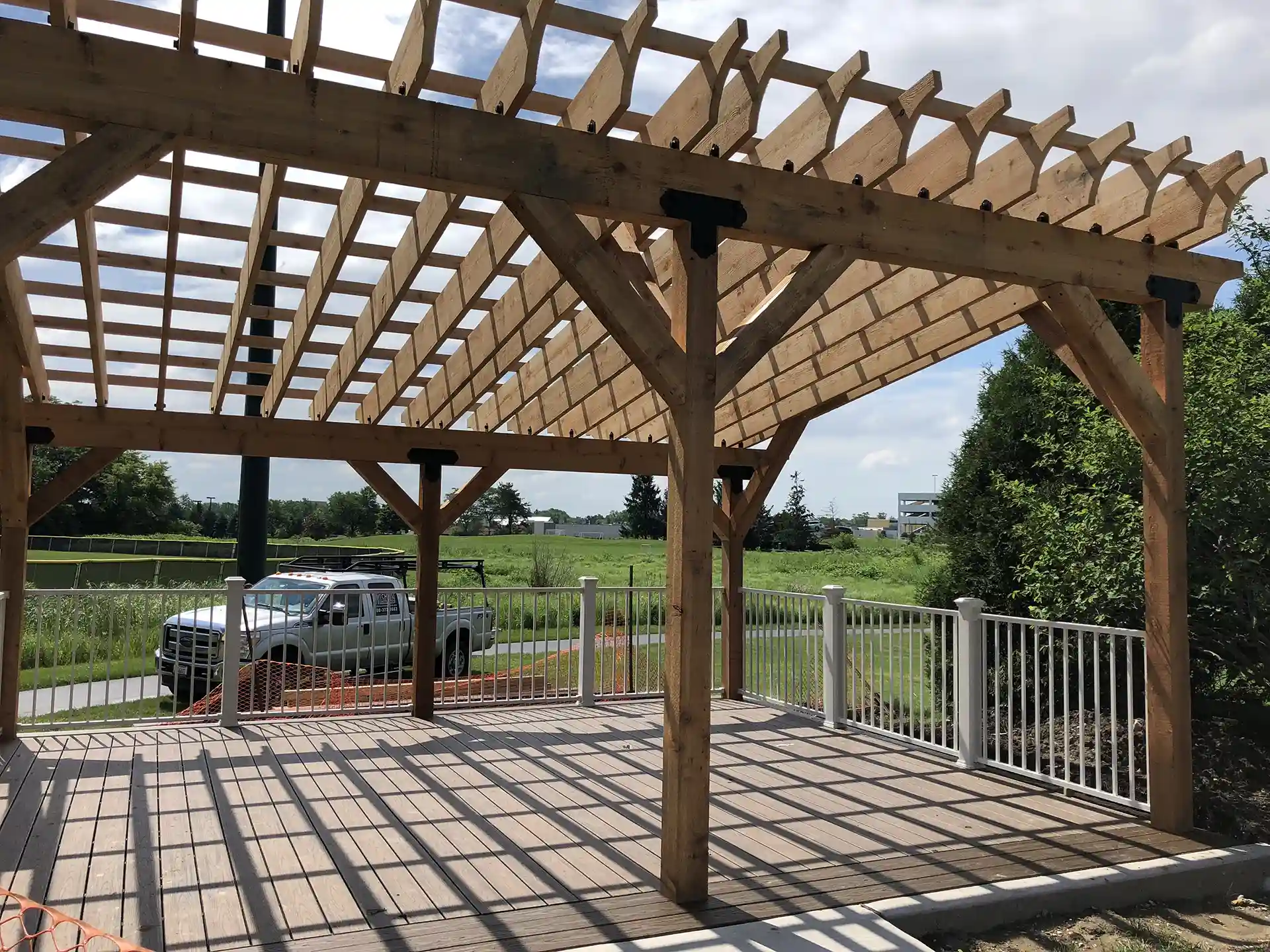Summer in Lockport, IL, is for grilling, relaxing, and soaking outdoors—but the fun stops fast when your deck heats up like a stovetop. You’re not alone if your deck becomes unusable in the afternoon sun. Fortunately, there are practical, beautiful, and science-backed ways to design a cooler deck space.
A deck that’s too hot can ruin your summer plans. This guide explains how to keep your deck cool in summer using airflow design, shading strategies, cool decking materials, and pool positioning that work well for Lockport’s climate.
Why Does Your Deck Get Hot in Summer?
Decks overheat primarily due to the way different materials respond to sunlight and how the structure interacts with airflow:
- Radiant Heating: When solar radiation—especially UV and infrared rays—strikes a deck surface, it is either reflected or absorbed. Darker and denser surfaces absorb more radiation and re-emit it as heat. The more sunlight absorbed, the hotter the surface gets.
- Thermal Mass: Materials like hardwood and dense composites have high thermal mass, storing more heat energy and releasing it slowly. This causes decks of these materials to stay hot well into the evening.
- Restricted Airflow: Without adequate spacing below or between decking boards, hot air becomes trapped beneath the surface, preventing natural cooling by convection.
- Sun Angle and Exposure: At Lockport’s latitude, south—and west-facing decks receive strong afternoon sunlight during summer, compounding heat gain.
Pro Tip: Decks can exceed 140°F on hot days, which can cause burns. Light-colored materials, built-in airflow, and shade structures can reduce surface temperatures by 30–40°F or more.
Decks overheat primarily due to the way different materials respond to sunlight and how the structure interacts with airflow:
- Radiant Heating: UV and infrared rays from the sun are absorbed by your deck’s surface. Darker surfaces absorb more of this energy and convert it into heat.
- Thermal Mass: Dense materials like hardwood retain more heat and release it slowly, staying hot into the evening.
- Restricted Airflow: Warm air becomes trapped and accumulates without open spaces underneath or between decking boards.
- Sun Angle and Exposure: South- and west-facing decks in Lockport get intense afternoon sun, further accelerating heat buildup.
Pro Tip: Decks can exceed 140°F on hot days—enough to cause burns. Light-colored materials, airflow, and shade can reduce that by 30–40°F.
Cool Decking Materials Lockport IL Homeowners Should Know
At Mitchell Construction, we offer and install premium composite brands that are durable and engineered to reduce surface temperatures, making them ideal for Lockport’s hot summers. These are the same trusted brands Mitchell Construction recommends and installs for long-lasting, low-maintenance decks that stay cooler in summer..
Composite Decking Lockport
Modern composite decking is engineered to resist heat better than traditional wood. At Mitchell Construction, we install top brands including:
- Trex® Transcend®: Known for its fade-resistant cap layer and light color options like “Island Mist.”
- TimberTech AZEK®: Capped PVC material with high Solar Reflectance Index (SRI) and moisture resistance.
- Fiberon CoolDeck®: Explicitly engineered for temperature reduction; stays up to 35% cooler.
- Deckorators Voyage: Mineral-based composite (MBC) includes microscopic air pockets to reduce heat absorption and surface temperature.
Why Wood Decking Gets Hotter
Natural wood absorbs and holds heat more than modern composites:
- Ipe and Cumaru: Dense, exotic hardwoods with low reflectivity and high thermal mass.
- Cedar and Redwood: Lighter woods that perform better but still require sealing and maintenance.
- Pressure-Treated Pine: Low-cost but quickly heats up in the sun, especially if stained a dark color.
Resurfacing Tip: If you have a hot, aging wood deck, consider upgrading to composite decking solutions from Mitchell Construction.
Passive Cooling: How Airflow for Decks Makes a Difference
Airflow reduces trapped heat and accelerates cooling through the physical principle of natural convection, which describes how warmer air rises and cooler air is drawn in to replace it.
When applied to decks, if the structure is properly vented, the warmer air accumulating beneath or around the decking boards will rise and escape, allowing cooler air to flow in from underneath or from the sides.
- Convection Currents: As the sun heats the decking surface and the air beneath it, the warmer air becomes less dense and begins to rise. If the area beneath the deck is open or vented, this upward flow pulls in cooler air, creating a continuous loop of air exchange that helps cool the structure and the surrounding space.
- Elevated Decks: Maintaining at least 18 inches of clearance between the ground and your deck joists allows air to flow freely underneath, promoting these convection currents.
- Vented Skirting: Decorative skirting should include airflow gaps, such as lattice or slatted designs, to avoid trapping heat under the deck.
- Drainage Systems: Under-deck drainage solutions like Trex RainEscape™ can incorporate ceiling fans or misting systems that work with airflow strategies to enhance cooling.
Local Tip: Lockport’s prevailing winds from the west-northwest in summer can help drive these airflow cycles when decks are oriented and appropriately vented.
Airflow reduces trapped heat and accelerates cooling through natural convection:
- Convection Currents: Warm air naturally rises. When your deck is elevated and vented, cooler air is drawn in underneath, and hot air escapes.
- Elevated Decks: Allow 18 inches of space under your deck for optimal ventilation.
- Vented Skirting: Use lattice or louvered panels to prevent heat from being trapped below.
- Drainage Systems: Under-deck drainage systems like Trex RainEscape™ can also incorporate ceiling fans or misters for added circulation.
Local Tip: Lockport’s breezy summer evenings can naturally enhance this airflow when your deck is adequately vented.
Shade Structures: Ideas to Keep Your Deck Cool in Summer
Cooling strategies for patios can also be highly effective for decks, where the exposure to heat is often more intense due to their elevated position and open structure. Many techniques to reduce heat on patios can be directly applied to decks, providing even greater comfort and relief from the sun.
Covered Deck
A covered deck is a permanent roof over your deck that protects from both UV rays and rain. It’s ideal for Lockport’s variable climate and offers opportunities to add fans, lighting, and all-weather furniture.
Pergolas
Pergolas are versatile, open-air structures that filter sunlight. Enhance them with:
- Retractable Canopies: Fabric panels that adjust with the sun.
- Tensioned Shade Cloths: Block high-angle rays.
- Climbing Plants: Grapevine or clematis offer natural, seasonal shade.
Pro Insight: Angle your pergola slats perpendicular to the afternoon sun path for maximum shading efficiency.
Screens and Fences
IMG_0533.JPG
Adding vertical shading features can help protect from low-angle sunlight and wind:
- Screens: Mesh or solid, fixed or retractable, they cool and create privacy.
- Fences: Great for structural shade and can support climbing plants for dual-purpose cooling.
Umbrellas & Shade Sails
- Cantilever Umbrellas: Freestanding and highly adjustable.
- Shade Sails: Modern, UV-blocking, and tensioned across open areas.
Layering Strategy: Combine fixed and flexible shade solutions—just as we recommend for patios—for all-day protection and aesthetic appeal.
Landscaping for Cooling: Plants That Make a Difference
Incorporating greenery near and around your deck helps cool your space through evapotranspiration, the process where plants release moisture into the air:
- Potted Trees: Strategically placed small trees provide mobile shade.
- Trellises with Vines: Use fast-growing species like trumpet vine or wisteria.
- Raised Planter Beds: Add beauty and break up heat-radiating surfaces.
Research-Backed Cooling Strategies
Decks bordered by well-positioned greenery can feel up to 10°F cooler.
Scientific studies support the effectiveness of specific strategies for keeping your deck cool in summer. These studies show that proper materials, cooling techniques, and design choices can significantly reduce surface temperatures, making outdoor spaces more enjoyable.
- A 2025 geothermal study showed that passive cooling systems, such as underground loop systems, can help dissipate heat from decks. While these systems are not yet commonly used in residential settings, they demonstrate how geothermal technology could be applied to outdoor living spaces.
- A 2023 building science study confirmed the benefits of green shading and reflective surface treatments. The research found that adding plants, vines, and light-reflective surfaces reduced surface temperatures by 7–10°F, making these natural solutions a cost-effective and straightforward way to keep decks cooler during summer.
Summer Deck Design Features and Cost Estimates
| Feature | Description | Cost Estimate |
| Covered Deck Roof | Full roof with ceiling fan/light | $$$$ |
| Pergola with Canopy | Adjustable slatted roof for filtered light | $$$ |
| Composite Deck Resurfacing | Replace old wood with composite decking | $$$ |
| Misting System | Cools air by 10°F using fine spray lines | $$ |
| Cantilever Umbrella | Flexible, movable shade | $ |
| Shade Sail Installation | Fixed UV-resistant fabric tension system | $$ |
| Screen or Fence with Vines | Natural privacy and shade wall | $$ |
| Outdoor Rugs & Mats | Add barefoot-safe, heat-blocking surfaces | $ |
FAQs
How do I keep my deck from getting hot?
Use cool decking materials Lockport IL builders recommend, such as capped composites with high Solar Reflectance Index (SRI). Combine this with ample airflow for decks and properly designed shade, like pergolas, umbrellas, or covered decks.
How to deal with a hot deck?
Add mobile shade (e.g., cantilever umbrellas or shade sails) and misting systems. If the deck is old or dark, resurfacing with light-colored composite decking Lockport options will significantly reduce surface temperatures.
How do I protect my deck from the sun?
Install a covered deck structure or adjustable shade system. Regularly apply UV-protective finishes on wood, or switch to low-maintenance composite boards that resist fading and heat.
Does wood decking get hot in the sun?
Yes. Dense woods like Ipe and even treated pine can become dangerously hot in direct sun. Unless shaded, they often exceed 130–140°F. Use light stains, maintain airflow, or switch to alternative materials.
What decks don’t get hot?
Decks made from mineral-based composite, capped PVC, or light-colored composite boards with airflow and shade for decks Lockport residents rely on tend to stay 20–40°F cooler than traditional wood.
How do I keep my deck from getting hot?
Use composite materials with high SRI values, improve deck airflow, and install pergolas or umbrellas for shade.
How to deal with a hot deck?
Lockport IL, builders recommend adding temporary or permanent shade, using misting systems, and switching to cool decking materials.
How do I protect my deck from the sun?
Install a covered deck, use UV-resistant stains on wood, or upgrade to capped composite boards.
Does wood decking get hot in the sun?
Yes—especially hardwoods and pressure-treated boards. Composite or PVC is much cooler.
What decks don’t get hot?
Mineral-based composite, capped PVC, and light-colored decking with built-in airflow and shade for decks. Lockport homes benefit the most.
Build a Cooler Deck with Mitchell Construction
If your deck is too hot to enjoy, we can help. Mitchell Construction builds decks designed to stay cooler through innovative use of materials, airflow design, and shade. We bring years of experience building for Lockport’s climate and know what works in full sun, tight spaces, and everything in between.
We don’t just build decks—we create outdoor spaces that feel good. Shaded, breezy, and built to handle the Lockport heat, our decks are made for everyday living, not just for show.
👉 Contact us today to talk about your deck project.





